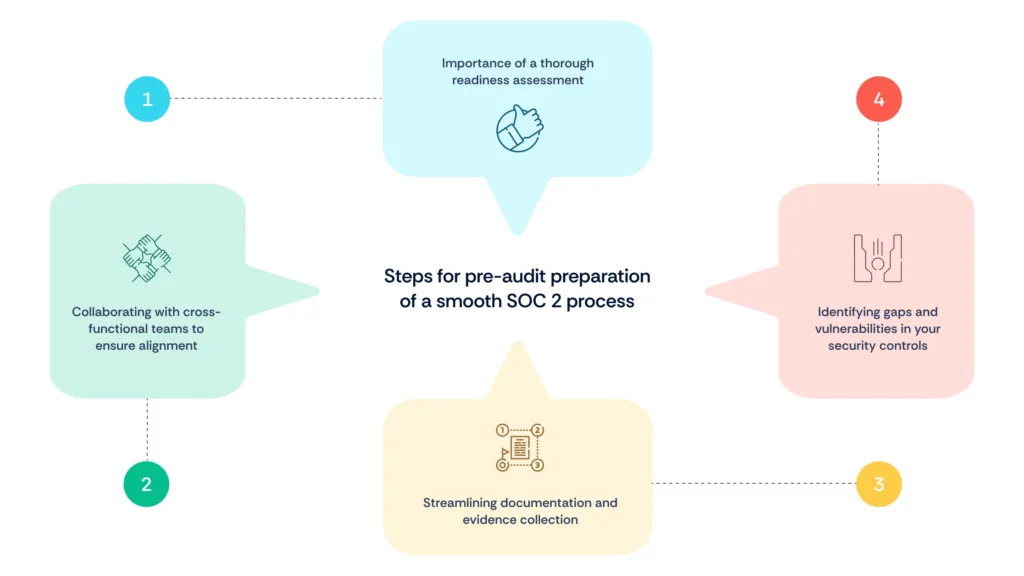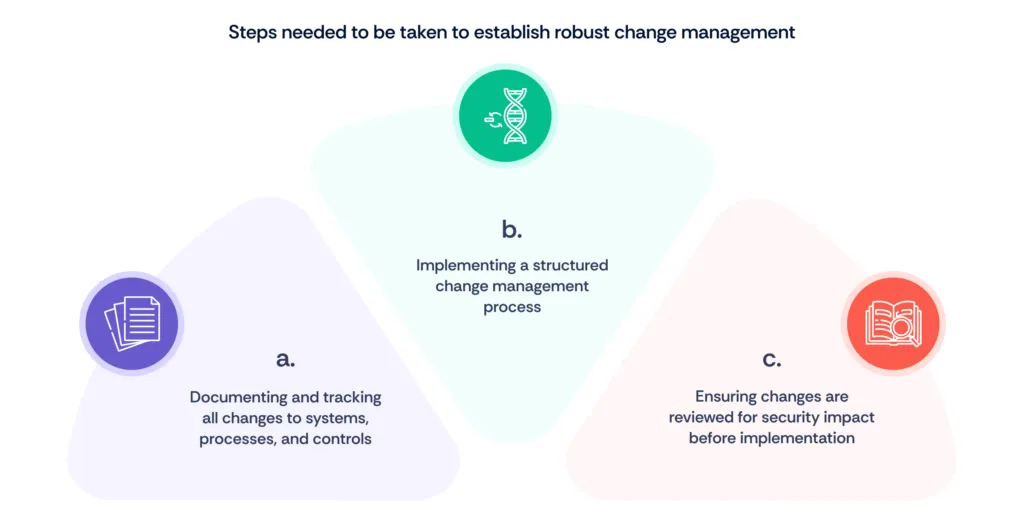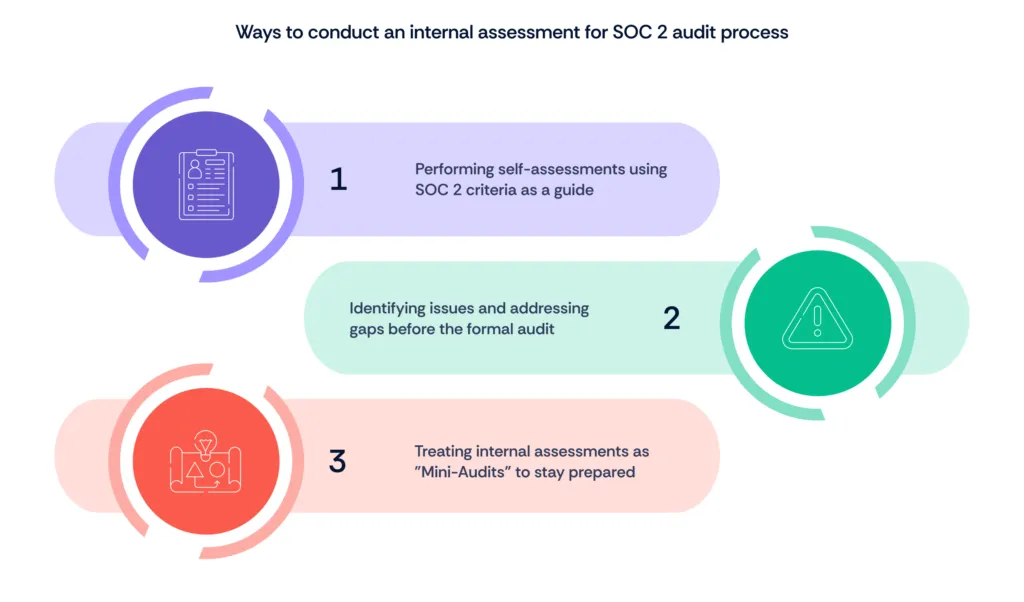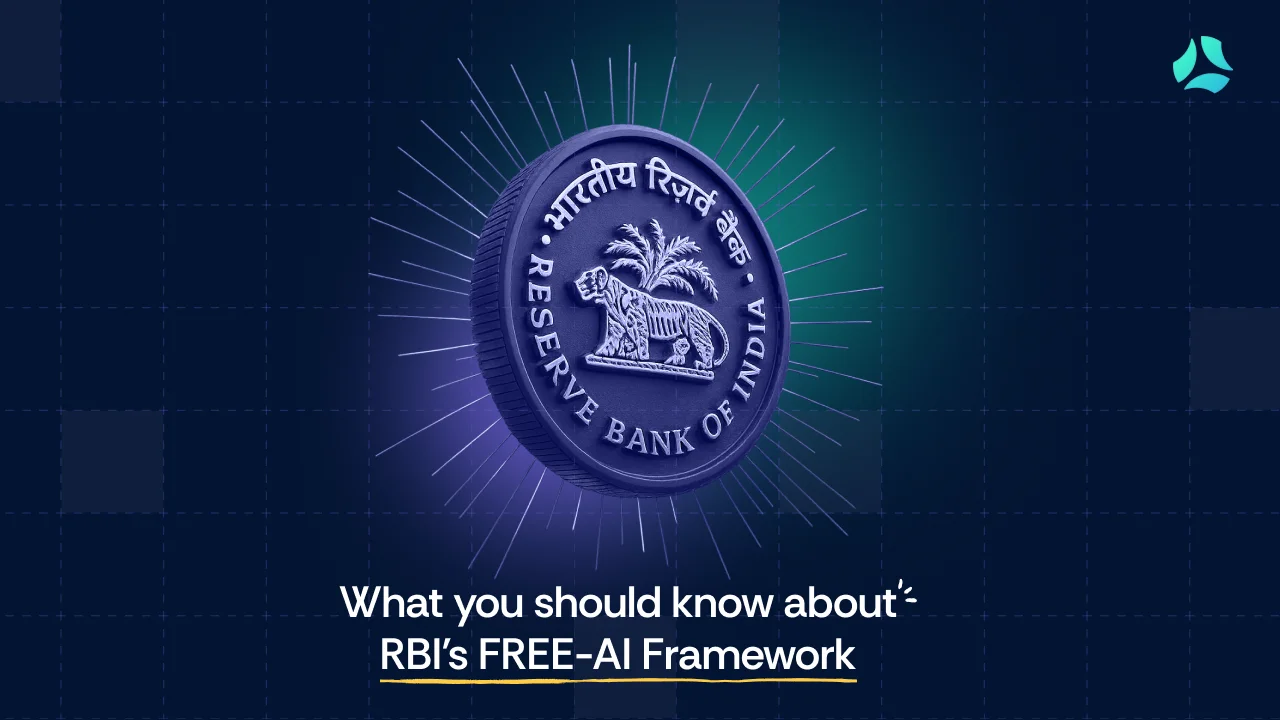7 Ways to Speed Up the SOC 2 Audit Process

In today's data-driven landscape, safeguarding sensitive information and upholding compliance standards are paramount. SOC 2 audits have emerged as a vital checkpoint for organizations seeking to demonstrate their commitment to data security, availability, processing integrity, confidentiality, and privacy. However, the road to SOC 2 compliance is not without its challenges, often accompanied by the constraints of time and resources.
As organizations recognize the significance of SOC 2 audits in fortifying their credibility and ensuring client trust, the need to streamline the audit process becomes increasingly apparent. The intricate nature of SOC 2 audits demands careful navigation, but the journey doesn't have to be arduous.
In this article, we delve into actionable strategies that empower security-conscious organizations to accelerate their SOC 2 audit process without compromising the integrity of their security posture.
7 ways to accelerate the SOC 2 audit process
So how long does a SOC 2 audit process take? You can refer to the whole SOC 2 process timeline in our blog here. For now, let's discuss seven ways in which an organization can accelerate the SOC2 audit process.
1. Pre-audit preparation: The foundation of a smooth SOC 2 journey

Before embarking on the SOC 2 audit journey, laying a strong foundation through meticulous pre-audit preparation is non-negotiable. This phase not only sets the tone for the entire process but also determines how effectively you can navigate the intricacies of the audit landscape.
A. Importance of a Thorough Readiness Assessment
Imagine stepping onto a battlefield without assessing the terrain – a recipe for disaster, right? Similarly, commencing a SOC 2 audit process without conducting a comprehensive readiness assessment can lead to unnecessary pitfalls. A readiness assessment involves evaluating your current security controls, policies, and processes against the SOC 2 audit requirements of the chosen Trust Services Criteria (TSC).
B. Identifying gaps and vulnerabilities in your security controls
A readiness assessment serves as a spotlight that illuminates the cracks in your security fortress. Identifying gaps and vulnerabilities in your security controls before auditors do allows you to proactively address these issues. By plugging these gaps, you not only bolster your data protection measures but also create a solid groundwork for a successful audit.
C. Streamlining documentation and evidence collection
The age-old adage "document, document, document" holds true in the realm of SOC 2 audits. Organized and comprehensive documentation is the bridge that connects your security measures to the audit criteria. Streamline the process by centralizing documentation, including policies, procedures, and control descriptions. This simplifies auditors' access to critical information and expedites the evaluation process.
D. Collaborating with cross-functional teams to ensure alignment
A SOC 2 audit isn't confined to the IT department alone. It's a collective effort that spans departments and teams, impacting everything from HR policies to data storage practices. Collaborate with cross-functional teams to ensure alignment and a shared understanding of security measures. This alignment minimizes confusion during the audit and demonstrates a cohesive commitment to data security and compliance.
In essence, the pre-audit preparation phase is your opportunity to shore up defenses, fill gaps, and gather the necessary armaments to face the audit with confidence. By conducting a thorough readiness assessment, identifying vulnerabilities, streamlining documentation, and fostering cross-functional collaboration, you lay the groundwork for a smoother SOC 2 audit journey.
In the next section, we'll delve into the importance of clearly defining the scope and objectives of the audit, a critical step that can significantly impact the efficiency of the process.
2. Clearly define scope and objectives: Navigating the SOC 2 audit path

As you tread deeper into the SOC 2 audit process, a pivotal crossroads awaits – defining the scope and objectives of the audit. This strategic step serves as the compass that guides your audit journey, ensuring that you navigate with precision and purpose.
A. Defining the scope of the audit based on relevant TSC
The TSC forms the backbone of SOC 2 audits, outlining the principles against which your organization's controls will be evaluated. To accelerate the audit process, carefully select the TSC that aligns with your business operations and customer expectations. Defining a tailored scope ensures that resources are focused where they matter most, streamlining the evaluation process.
B. Aligning the audit scope with your organization's services and systems
A common misstep is attempting to encompass every facet of your organization under the audit's umbrella. Rather than casting a wide net, align the audit scope with the specific services and systems that interact with customer data or impact their security. This precision not only accelerates the audit but also ensures that your clients' concerns are directly addressed.
C. Setting specific and measurable audit objectives to guide the process
Goals without direction are like ships without a rudder – they drift aimlessly. To maintain momentum throughout the audit, establish clear and measurable objectives. These objectives not only guide your efforts but also provide auditors with a roadmap of what to expect. Think of them as milestones that help you track progress and measure success.
By strategically defining the scope and objectives of the audit, you not only steer clear of unnecessary detours but also pave a streamlined path for both your team and auditors. In the upcoming section, we'll delve into the realm of automation and continuous monitoring, two potent tools that can significantly expedite the audit process.
3. Implement continuous monitoring: The vigilance that fuels SOC 2 success

In a landscape where data threats evolve at breakneck speed, relying solely on periodic check-ins won't suffice. Enter continuous monitoring – a dynamic approach that infuses your SOC 2 audit process with real-time vigilance and actionable insights.
A. Leveraging automated monitoring tools for real-time threat detection
Gone are the days when manual surveillance was the norm. Automated monitoring tools serve as your digital sentinels, tirelessly scanning your systems for anomalies, unauthorized activities, and potential breaches. These tools not only accelerate threat detection but also free up valuable resources that can be redirected toward refining security strategies.
B. Continuous monitoring of security controls and compliance measures
Compliance isn't a one-time achievement; it's an ongoing commitment. Continuous monitoring extends beyond threat detection and encompasses the consistent assessment of your security controls against the established criteria. This approach ensures that you remain compliant at all times, reducing the last-minute scramble to align with SOC 2 audit requirements.
C. Regularly reviewing logs, alerts, and anomalies to stay proactive
Automation isn't a set-it-and-forget-it solution. Regular review of monitoring logs, alerts, and anomalies is the heartbeat of your continuous monitoring strategy. By promptly addressing identified issues, you preemptively mitigate potential risks, enhancing your security posture and bolstering your credibility during the audit.
Embracing continuous monitoring isn't just a technological upgrade; it's a mindset shift that aligns your organization with the fast-paced nature of security threats. As we venture forth, we'll explore the realm of change management – a strategic approach that ensures your security measures evolve with the evolving threat landscape.
4. Establish robust change management

In a digital ecosystem defined by perpetual change, maintaining a proactive stance is non-negotiable. Robust change management emerges as a lighthouse, guiding your organization through the turbulent waters of evolving security landscapes.
A. Documenting and tracking all changes to systems, processes, and controls
Every alteration, regardless of its scale, has a ripple effect on your security landscape. Documenting and tracking these changes, be it in systems, processes, or controls, is your compass to navigate through the intricate web of your security infrastructure. This record not only serves as a historical reference but also provides auditors with a transparent view of your security evolution.
B. Implementing a structured change management process
Chaos has no place in change. Implementing a structured change management process is akin to laying tracks for a speeding train. Define clear roles, responsibilities, and procedures for proposing, reviewing, approving, and implementing changes. This structure not only minimizes confusion but also expedites the decision-making process, allowing your security measures to evolve swiftly and seamlessly.
C. Ensuring changes are reviewed for security impact before implementation
Change should be a guardian, not a gateway to vulnerabilities. Before any change sees the light of day, it's imperative to assess its potential security impact. This pre-implementation review, involving security experts and stakeholders, acts as a safety net, preventing inadvertent security breaches or lapses.
As you establish a robust change management framework, you're not just adapting to the shifting sands of security – you're shaping your organization's security destiny. In our next section, we'll delve into the realm of meticulous documentation and evidence gathering, a practice that transforms the audit journey from a hunt to a seamless unveiling.
5. Prioritize documentation and evidence gathering: Weaving the tapestry of assurance

In the intricate dance of SOC 2 audits, documentation, and evidence stand as your partners in proving your commitment to security and compliance. Prioritizing these elements isn't just about compliance – it's about painting a vivid picture of your security landscape.
A. Maintaining well-organized and up-to-date documentation
Imagine trying to navigate a labyrinth without a map – chaotic and confusing. Your documentation acts as that map, guiding auditors through your security controls and processes. Keep your documentation well-organized and up-to-date to minimize ambiguity and expedite the audit process.
B. Establishing a central repository for evidence and supporting materials
A scattered trail of evidence is a recipe for frustration – both for auditors and your team. Create a centralized repository for evidence and supporting materials. This repository not only streamlines auditors' access to essential information but also serves as your vault of proof, demonstrating your adherence to security controls.
C. Proactively collecting evidence throughout the audit period to minimize last-minute efforts
Last-minute scrambles are notorious for inducing stress and compromising quality. To avoid this, adopt a proactive approach by collecting evidence throughout the audit period. Regularly updating your repository with recent evidence not only lightens the load but also positions you as a prepared and conscientious organization.
As you prioritize documentation and evidence gathering, you're essentially crafting a narrative of trust and reliability. This narrative not only propels your SOC 2 audit forward but also fosters a culture of accountability and transparency. In our next section, we'll delve into the realm of internal assessments – the rehearsals that refine your performance on the audit stage.
6. Conduct regular internal assessments: Polishing your armor through self-examination

In the world of SOC 2 audits, preparation isn't a one-time event; it's an ongoing commitment. Regular internal assessments serve as your training ground, refining your security posture and fortifying your defenses against potential vulnerabilities.
A. Performing self-assessments using SOC 2 criteria as a guide
Think of self-assessments as your dress rehearsals for the grand performance. Use the SOC 2 criteria as your script, evaluating your security controls, policies, and procedures against these standards. This proactive approach not only identifies gaps but also familiarizes your team with the audit expectations.
B. Identifying issues and addressing gaps before the formal audit
Self-awareness is your most potent weapon against complacency. Use internal assessments to uncover issues and address gaps before auditors do. This preemptive action not only streamlines the audit process but also safeguards your organization's reputation and client trust.
C. Treating internal assessments as "Mini-Audits" to stay prepared
Treat internal assessments as more than mere checklists – treat them as "mini-audits." Emulate the rigor and thoroughness of an actual audit, including documentation review, evidence collection, and stakeholder involvement. This approach not only keeps you prepared but also instills a culture of continuous improvement.
Regular internal assessments transcend the role of mere practice; they're the crucible in which your security measures are refined, and your response to potential challenges is honed. In our final section, we'll explore the art of collaboration with auditors, a partnership that can illuminate your audit journey.
7. Collaborate effectively with auditors: Crafting a synchronized audit symphony

As the SOC 2 audit draws nearer, the spotlight shifts to effective collaboration with the conductors of the audit, the auditors. This partnership isn't just a formality; it's a harmonious collaboration that can significantly impact the tempo and efficiency of the audit process.
A. Engaging auditors early in the process to align expectations
A harmonious performance begins with a shared understanding. Engage auditors early in the process to align expectations, discuss audit scope, and clarify any queries. This dialogue not only fosters transparency but also eliminates surprises as you progress through the audit.
B. Providing auditors with timely access to necessary information
Imagine trying to solve a puzzle without all the pieces—frustrating, right? Provide auditors with timely access to the necessary information, documentation, and evidence. This proactive approach accelerates their evaluation and demonstrates your commitment to a seamless audit experience.
C. Establishing open communication channels for addressing questions and concerns
Communication is the glue that binds collaboration. Establish open communication channels for auditors to address questions and concerns promptly. Your willingness to provide clarifications not only expedites the audit process but also fosters an atmosphere of mutual respect and cooperation.
The collaboration with auditors isn't a hurdle to cross; it's a partnership that amplifies your efforts, elevates your security posture, and showcases your commitment to compliance. By engaging early, providing timely access, and fostering open communication, you're orchestrating a harmonious audit journey that concludes with a standing ovation.
Conclusion: Your SOC 2 Acceleration Journey
Navigating the intricate terrain of SOC 2 audits requires more than just technical prowess; it demands a strategic mindset, meticulous preparation, and effective collaboration. As we conclude this journey through seven expert strategies, remember that accelerating the SOC 2 audit process isn't about cutting corners; it's about optimizing your efforts and resources to ensure a seamless, efficient, and compliant audit journey.
By prioritizing pre-audit preparation, defining the scope, embracing continuous monitoring, establishing change management, valuing documentation, conducting internal assessments, and collaborating with auditors, you empower your organization to navigate the SOC 2 audit landscape with confidence. Embrace these strategies not as standalone solutions, but as interlocking pieces of a puzzle that, when assembled, create a picture of security, compliance, and trust.
So, as you embark on your SOC 2 audit journey, armed with these strategies, remember that success lies not just in the destination, but in the voyage itself. Secure, accelerate, and triumph.
FAQs
Why is the SOC 2 audit process important? SOC 2 audits assess an organization's commitment to data security, availability, processing integrity, confidentiality, and privacy. Successfully passing these audits enhances client trust and demonstrates compliance with rigorous industry standards.
What challenges are associated with SOC 2 audits? SOC 2 audits can be time-consuming and resource-intensive. Navigating complex criteria, ensuring consistent compliance, and managing documentation can pose challenges for organizations.
How can I accelerate the SOC 2 audit process without compromising quality? Our blog outlines seven expert strategies, including pre-audit preparation, clear scope definition, continuous monitoring, robust change management, prioritizing documentation, regular internal assessments, and effective collaboration with auditors.


















